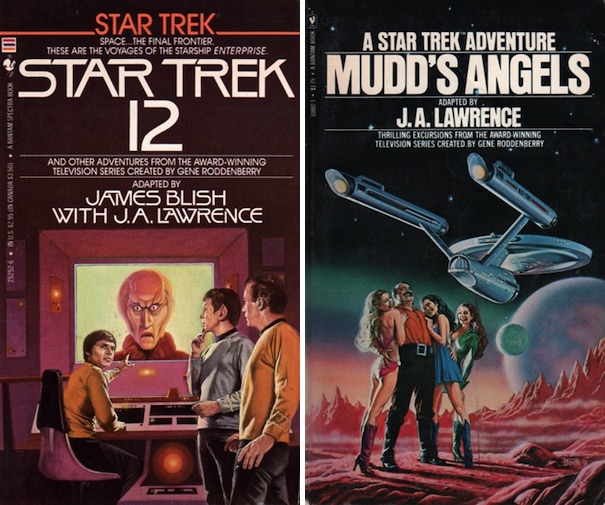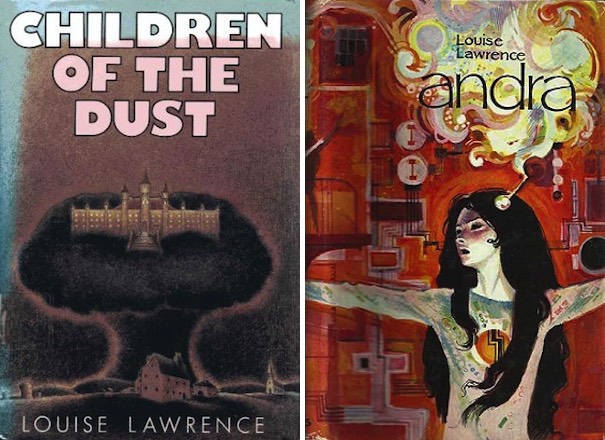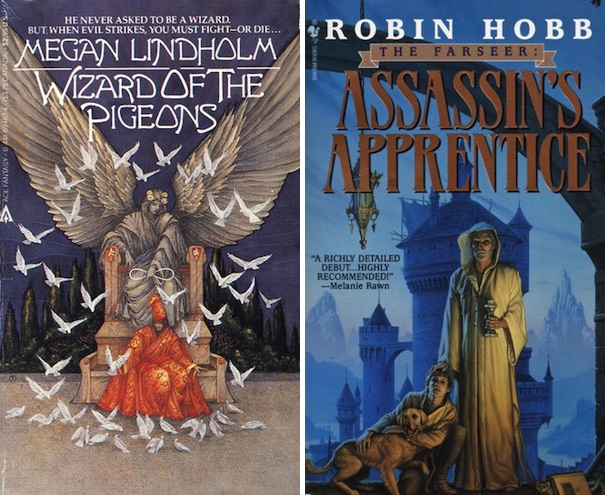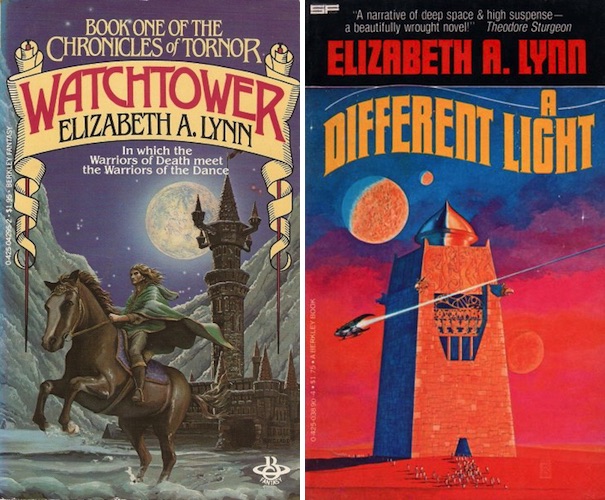Once more we venture into the 1970s, this time to celebrate women who debuted between 1970 and 1979 and whose surnames begin with the letter L.
The five previous instalments of the series cover women writers with last names beginning with A through F, those beginning with G, those beginning with H, those beginning with I & J, and those beginning with K.
J.A. Lawrence

J.A. Lawrence may be best known as an illustrator, but she is also an author. She is perhaps best known for “Getting Along” (featured in 1972’s Again, Dangerous Visions) as well as for the collection Star Trek 12, which was part of a long-running series adapted from scripts of the original Star Trek. While many of her works were co-authored with her then-husband, the late James Blish, 1978’s Mudd’s Angels is a solo work by Lawrence.
Louise Lawrence

Louise Lawrence’s work was sometimes classified as young adult, presumably because of the fact that her protagonists tended to be young. However, her subject matter was often grim. 1985’s Children of the Dust is a case in point: it’s a multi-generation examination of the effects of nuclear war. It is every bit as jolly as that other British children’s classic, Threads. (Note: Lawrence is the pen name of Elizabeth Holden, but since her works are published entirely under the former name, I’m going with the former.)
Tanith Lee

Tanith Lee was incredibly prolific. I’ve reviewed over sixty of her books and haven’t come close to reviewing them all. Over the more than four decades of her career, she ranged across science fiction, fantasy, horror, and other genres. For reasons I do not fully understand, her popularity in North America declined precipitously after 1990 or so. This was perhaps due to a disastrous attempt by her North American publisher to position Lee as a horror author—just in time for a downturn in horror sales (which tend to cycle). Of all the books by Lee I’ve read, I’d recommend her 1983 collection Red As Blood, which takes its title from a 1979 story contained therein. Fans of Neil Gaiman’s 1994 “Snow, Glass, Apples” may find this story of interest.
[Michael Whelan cover, please. The new one makes me sad]
Megan Lindholm

Under which name to cover Megan Lindholm? That’s her real-world name, but she is probably better known to readers by her pen name, Robin Hobb. She has been a professional writer since the 1970s, when Jessica Amanda Salmonson picked Lindholm’s “Bones for Dulath” for the World Fantasy Award-winning DAW collection Amazon! (whose cover is proof that even cover artists of the 1970s were in fact able to give women functional armour, even if they did not often exercise this option). Lindholm, writing as Robin Hobb, is the author of the popular Realm of the Elderlings books. Still, we’re on L and not H, so instead of a Hobb novel I will suggest reading Lindholm’s urban fantasy Wizard of the Pigeons. This book touches on themes such as mental illness and poverty that may make this a non-comfort-read. It is nevertheless a good read.
Jean Lorrah

Jean Lorrah, (whose frequent co-author Jacqueline Lichtenberg is disqualified for this series by dint of a late-1960s publication) isn’t an author whose work I know well. I am most familiar with the Lorrah-Lichtenberg long-running Sime-Gen series, in which the needs and desires of the Simes (obligate psychic vampires) and the Gens (food) come into frequent conflict; it’s as though people do not appreciate having their souls consumed by their social superiors¹. The place to begin is always the beginning, which in this case is 1980’s First Channel.
Elizabeth A. Lynn

Active since the mid-1970s, Elizabeth A. Lynn’s early stories, often featuring favourably portrayed gay characters (a rarity in those days), earned her a Campbell nomination. In 1980 she won the World Fantasy Award not once but twice, for Watchtower (first volume in the Chronicles of Tornor) and for her short piece, “The Woman Who Loved the Moon.” The now-defunct chain of LGBT bookstores took its name from her novel, A Different Light, which focused on the final days of a man who chose to embrace the lethal side effects of faster-than-light travel rather than a long, dull life lived at home. Her body of work is not as large as some, but, as you can see, it is quite remarkable. I recommend beginning with The Watchtower, in which a man-at-arms and his prince find themselves survivors of a sudden, brutal invasion.
* * *
I read science fiction and fantasy exhaustively back when I was still a teenager, but my reading was not comprehensive. The vagaries of Canadian book distribution meant that I might overlook or never encounter various authors. Thus my list of shame, authors about whom I am currently uninformed:
- Samantha Lee
- Kay Leith
- Betty Levin
- Penelope Lively
- Morgan Llywelyn
- Eileen Lottman
- Alice Low
- Lois Lowry
If you’ve read works by these writers, please share your impressions.
1: I am being a little unfair here, because Simes consume something called selyn, which Gens produce in excess. The process of extracting selyn is only fatal if the Gen feels fear during the feeding process. All the Gen has to do to survive is avoid this emotion…which is unfortunately a frequent side effect of the knowledge that the process to which they are being involuntarily subjected is potentially lethal.
In the words of Wikipedia editor TexasAndroid, prolific book reviewer and perennial Darwin Award nominee James Davis Nicoll is of “questionable notability.” His work has appeared in Publishers Weekly and Romantic Times as well as on his own websites, James Nicoll Reviewsand Young People Read Old SFF (where he is assisted by editor Karen Lofstrom and web person Adrienne L. Travis). He is surprisingly flammable.










